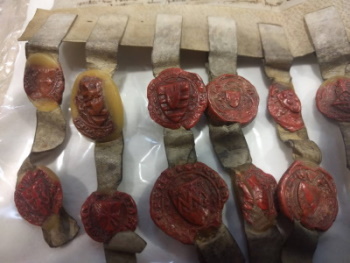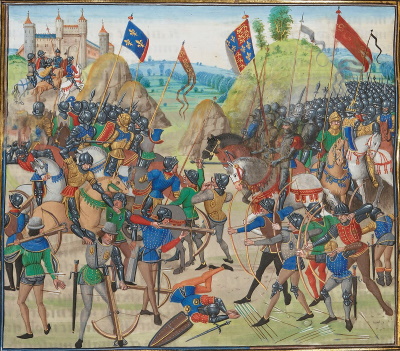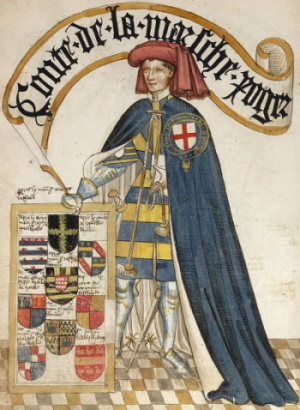The Rehabilitation of the Mortimers
Edmund Mortimer (d1331)
Roger Mortimer, 2nd Earl of March (1328-1360)
Edmund Mortimer (d1331)
Despite the 1st Earl of March’s closeness to Queen Isabella in the final years of his life, he and his wife Joan previously had 20 years of successful marriage which included 12 children. The oldest boy, Edmund, was probably born in 1302. At the age of 14 he was married to Elizabeth de Badlesmere who was just 3 years old. Following his father’s arrest and subsequent exile, Edmund was imprisoned with his brothers, first in Windsor castle and then in the Tower. Freed on Roger’s triumphant return to England with the queen, he was knighted with his brothers by the young Edward III. A year later, in 1328, his wife Elizabeth gave birth to their first child, another Roger.
Following the Earl’s trial and execution in 1330, his extensive estates and the earldom of March were forfeit. The Mortimers of Wigmore were then living in very reduced circumstances. Perhaps contrary to expectations, however, the new king proved charitable and forgiving. Roger’s widow, Joan, was treated kindly and most of her lands were eventually given back to her. As early as 1331, various lords were urging the king to be generous to Roger’s son Edmund and in October he restored Wigmore to him, together with Maelienydd and other lands in Wales. And he went further: a month later Edmund was called to attend parliament and is consequently held to have become Baron Mortimer, a new creation distinct from that forfeited by his father.
Things were looking good and Edmund must have hoped that he would gradually recover more of his father’s lands and significance. Tragically, within a month of the parliament, he died of a fever. Aged about 28 when his father died, Edmund was the last lord of Wigmore to be an adult when he succeeded his father. From now on until the male line failed in 1425, it is a story of successive lords dying young, to be succeeded by minors. Over that period the last four lords of Wigmore had direct control of their estates for a total of only 41 of the 94 years.

Seals on the 1316 document in which Edmund
Mortimer assigns dower to his young wife
Elizabeth de Badlesmere – note the Mortimer arms
Roger Mortimer, 2nd Earl of March (1328-1360)

Roger recovered Wigmore at the age of just 13
Just 3 years old when his father died, and with his grandfather’s execution and attainder in the background, things didn’t look very promising for Roger. Yet by the time of his death at the young age of 31 he had completely restored the family fortunes and become one of the greatest magnates in England, much lamented by the same king who had executed his grandfather.
He was fortunate in having good connections. Following the death of his father, his mother married William de Bohun, one of Edward III’s close companions. Another of Edward’s friends, William Montagu took practical steps to help him as did Richard Fitzalan, Earl of Arundel. In 1341 he was allowed to take control of Radnorshire and the following year, aged just 13 he recovered Wigmore, with further Welsh estates following.
But it was Roger’s character and personal qualities that were to make the real difference. Vendettas could last for many years: Hugh Despenser had sworn eternal enmity against Roger’s grandfather, the 1st Earl of March, because Mortimer’s grandfather had slain Despenser’s grandfather at the Battle of Evesham. So, given the fate of his own grandfather, it would not have been surprising if relations between young Roger and Edward III had been strained, to say the least. It is quite surprising, therefore, that he became one of Edward’s most loyal and trusted supporters and lieutenants.
Roger’s teenage years were a time when Edward III was ramping up his claim to the throne of France. In a provocative move he changed the royal coat of arms, adding the arms of France to the lions of England, and the pursuit of this claim was to result in the Hundred Years War. Roger’s potential as a soldier became clear at an early age. He was only 15 when he distinguished himself at a tournament held in Hereford in 1345, taking part alongside many of the most noble lords in England. Only 2 years later, aged just 17, he crossed to France as part of the king’s army and was knighted by the Black Prince at La Hogue. He fought alongside the king at the battle of Crécy and was rewarded by being given livery of all his lands in Herefordshire and the Marches.
The following year, 1348, Roger was summoned to parliament as both Baron Mortimer and Baron Mortimer of Wigmore. He was further honoured by being selected as one of about 25 founder knights of the Order of the Garter, a distinction which remains the highest order of chivalry in the United Kingdom. In 1354 he was successful in securing the reversal of his grandfather’s attainder, allowing him to gain control of all his the 1st earl’s estates except those held in dower by his mother and grandmother, both of who were to die in 1356. Even more significantly as far as his image was concerned, he was able to inherit his grandfather’s earldom and become the 2nd Earl of March.

The Battle of Crécy as imagined
by Froissart in the 15th century

Roger Mortimer, 2nd Earl, in his Garter robes
Meanwhile he was continually active as a soldier both in France and against the Scots. In 1354 he was in Avignon as part of the unsuccessful peace negotiations brokered by the Pope. The following year he was at Roxburgh when Edward Balliol finally surrendered his claim to the throne of Scotland. Roger was one of Edward III’s key commanders in the 1358 invasion of France, being given the role of constable and personally leading a force of 600 men-at-arms and 1000 archers, mostly recruited from his own estates in Wales.
He was now one of the most powerful men in England. With the death of his grandmother he acquired Ludlow castle which became a favourite residence. Trusted and appreciated by the king, he was awarded the positions of constable of Montgomery, Bridgnorth and Corfe castles as well as keeper of Clarendon forest, Dover and the Cinque Ports. However not everyone was delighted by the rehabilitation of the Mortimers. Several families had benefited from the fall of the 1st Earl of March, but they now had to cope with these gains being unceremoniously taken away from them and given to the young Mortimer. These included the Berkeleys, Talbots and Montagus, but Edward III was not interested in listening to their complaints. Roger had married William Montagu’s daughter Philippa, but the relationship between the two men was subsequently soured by a bitter feud over the lordship of Denbigh.
Roger and Philippa are recorded as having 4 children but a fifth child, Thomas, may have been legitimately born around the time of Roger’s death. Thomas may, however, have been illegitimate, but either way he was to play a big part in the later Mortimer story. All was looking good for the young earl when he suddenly died at Rouvray near Avalon in Burgundy. According to Froissart, Edward III loved him dearly and he was greatly upset by his death.